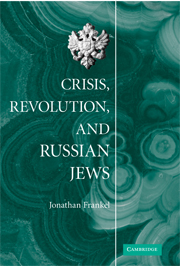Book contents
- Frontmatter
- Contents
- Acknowledgments
- Introduction
- PART I NEW DYNAMICS?
- PART II REVOLUTION AND WAR (1905–1921)
- PART III IDEOLOGICAL CONFLICT AND CONTINUITY
- PART IV OVERSEAS
- PART V HISTORY AND THE HISTORIANS
- 10 S. M. Dubnov: Historian and Ideologist
- 11 Assimilation and the Jews in Nineteenth-Century Europe: Toward a New Historiography?
- Index
11 - Assimilation and the Jews in Nineteenth-Century Europe: Toward a New Historiography?
Published online by Cambridge University Press: 07 August 2009
- Frontmatter
- Contents
- Acknowledgments
- Introduction
- PART I NEW DYNAMICS?
- PART II REVOLUTION AND WAR (1905–1921)
- PART III IDEOLOGICAL CONFLICT AND CONTINUITY
- PART IV OVERSEAS
- PART V HISTORY AND THE HISTORIANS
- 10 S. M. Dubnov: Historian and Ideologist
- 11 Assimilation and the Jews in Nineteenth-Century Europe: Toward a New Historiography?
- Index
Summary
The life and thought of the Jewish people in nineteenth-century Europe is rarely described today, in accord with the basic concept which dominated the history books until some twenty years ago. True, the process of revision has been anything but dramatic. Among the historians who write on nineteenth-century Jewry there have been no great public disputes over method or content, nothing comparable to the fierce debates engendered by the cliometric studies of American slavery, for example, or by the structuralist and deconstructionist schools in contemporary literary criticism. No revisionist school of historiography has proclaimed its existence in this field; nor, in many, perhaps even most, cases, were the individual historians involved aware (at least initially) of being engaged in a broader revisionist trend.
A major contribution to the change of perspective has undoubtedly been made by a number of American historians. But the re-mapping of modern Jewish history has not been confined to any one country (Israeli historians, too, have been strongly represented) nor to any one generation.
What became the historiographical orthodoxy in this field for a number of decades – in most marked form from the 1930s until the 1960s – had its origins in the Tsarist Empire. In general terms, it was a major by-product of the modern Jewish nationalism which surged up in the Pale of Settlement following the pogroms of 1881–2 and which, despite ebbs and flows, sustained its momentum throughout the reigns of Alexander III and Nicholas II.
- Type
- Chapter
- Information
- Crisis, Revolution, and Russian Jews , pp. 276 - 310Publisher: Cambridge University PressPrint publication year: 2008



